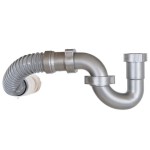Bathroom Faucet Water Line Size: Understanding the Basics
The water line size for a bathroom faucet is a crucial aspect of plumbing that often goes unnoticed until a problem arises. A properly sized water line ensures adequate water pressure and flow for your faucet, while an undersized line can lead to frustratingly low water pressure and even damage to your fixture. This article aims to provide a comprehensive understanding of bathroom faucet water line sizes, exploring the factors that influence sizing and the potential consequences of selecting the wrong size.
Factors Influencing Water Line Size
Several factors contribute to determining the appropriate water line size for a bathroom faucet. These include:
- Faucet Type: Different faucet types require varying water flow rates. High-flow showerheads or kitchen faucets with multiple spray settings will necessitate larger water lines than a standard bathroom sink faucet.
- Water Pressure: The water pressure within your home also plays a significant role. Low water pressure can necessitate larger water lines to compensate for reduced flow.
- Distance from Water Supply: The distance between the water supply line and the faucet can impact water pressure. Longer distances often require larger water lines to maintain sufficient flow.
- Number of Fixtures: Having multiple fixtures sharing a single water line can reduce pressure to each individual fixture. If several bathroom fixtures are connected to the same supply, larger water lines may be necessary.
Common Water Line Sizes for Bathroom Faucets
The most common water line sizes for bathroom faucets are:
- 1/2-Inch: This is the standard size for most bathroom faucets and is generally suitable for single-handle faucets with average flow rates.
- 3/8-Inch: This size is commonly used for older homes or fixtures with lower flow rates. It is not recommended for modern faucets with high flow rates.
- 1/4-Inch: This size is rarely used for bathroom faucets, typically reserved for low-flow applications or for connecting to a water heater.
Consequences of Incorrect Water Line Sizing
Choosing the wrong water line size can lead to several problems, including:
- Low Water Pressure: An undersized water line restricts water flow, resulting in low pressure and a weak stream.
- Inefficient Water Usage: With low water pressure, it may take longer to fill a sink or tub, leading to increased water consumption.
- Faucet Damage: Insufficient water pressure can cause a faucet's internal components to wear out prematurely.
- Compromised Water Quality: Reduced water flow can lead to air pockets within the water line, potentially introducing sediment or debris into the system.
Determining the Appropriate Water Line Size
Determining the correct water line size for your bathroom faucet involves considering the factors mentioned above. If you are unsure, consulting a professional plumber is always a good idea. They can assess your existing plumbing system and determine the appropriate water line size to ensure optimal water pressure and flow.

What Size Are Faucet Supply Lines For All Faucets Tck

What Size Are Faucet Supply Lines For All Faucets Tck

What Size Supply Line Is Needed For A Kitchen Faucet Mr Faucets

What Size Are Faucet Supply Lines For All Faucets Tck

Bwe 32 In Braided Stainless Steel Supply Hose 3 8 Female Compression Thread X M10 Male Connector 2 Piece A 9h 80 The Home Depot

How To Measure For A Cloth Diaper Sprayer

What Is The Common Water Line Size Under A Sink Hunker

The Plumber S Choice 1 2 In Ips X 3 8 Compression 20 Braided Faucet Supply Connector Pack Nl 27120 Home Depot

Reliabilt 3 8 In Compression X 1 2 Fip 20 Braided Stainless Steel Flexible Faucet Supply Line The Toilet Lines Department At Com

The Plumber S Choice Toilet Connector Water Line 3 8 In X 7 Female Compression Balcock Nut Supply 24 Nl 27424 Home Depot
Related Posts







